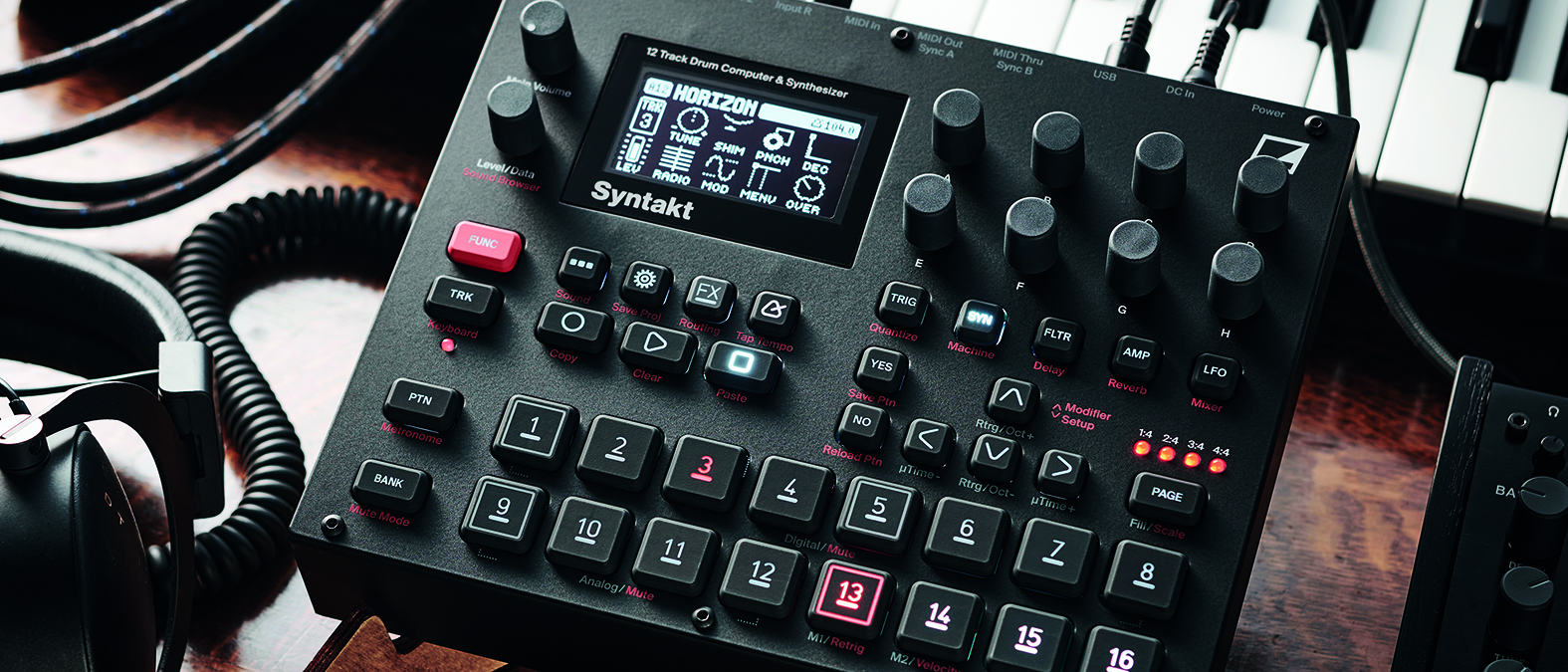MusicRadar Verdict
Building on the successes of multiple other Elektron instruments, Syntakt is a top quality groovebox with a lot of power under the hood.
Pros
- +
Excellent balance of analogue and digital sound sources.
- +
Percussive synths double up as meaty melodic generators, now enhanced with SidStation-style sounds.
- +
Deep sequencing workflow, complemented by Overbridge compatibility.
- +
Euclidean sequencer is a great addition.
Cons
- -
Limited hardware I/O.
- -
Workflow will likely still take some getting used to, for those new to Elektron gear.
MusicRadar's got your back
Elektron first released its Syntakt groovebox in 2022. Combining elements of both analogue and digital sound generation, it immediately impressed us for its sonic versatility and the flexibility of its sequencing. Now, in 2024, Elektron has released a significant OS update, version 1.30, which adds four new sound engines along with sequencing and quality of life improvements.
In light of this upgrade, we’ve re-tested the Syntakt and updated our review to reflect the latest version.
Elektron Syntakt: What is it?
In the early 2010s, Elektron was known as a brand responsible exclusively for deep, high-end gear. The likes of Octatrack, Analog Rytm and Analog Four were up there with the best hardware instruments on the market, but prices for each hovered at the £1k mark and you’d need a week to read the manual.
Over the past decade the Swedes have dipped into more affordable territory, right down to Model:Cycles and Model:Samples, each of which can be picked up for under £300.
Arguably, however, the point where Elektron really hit the ‘sweet spot’ was with the launch of Digitakt, its mid-priced, multi-track sampler – recently upgraded with a full version II release. While Digitakt is undeniably more accessible than Elektron’s other sampler, Octatrack, it still boasts plenty of the depth and creativity we now associate with Elektron gear. A similarly priced and sized follow-up, Digitone repeated this but with a unique take on FM synthesis.
On the surface, Elektron’s Syntakt groovebox appears to be a neat third entry into this range. It comes housed in a chassis that’s the same size as both of those instruments, with a control layout almost identical to that of Digitakt. There is certainly a lot that’s similar across the trio, particularly when it comes to the sequencing workflow. For all that Elektron gear can take a bit of getting used to – and there are still plenty of eccentricities on show here – prior users of Digitakt and Digitone will find themselves instantly at home with Syntakt’s layout/design.
What makes this more than simply a synth-minded version of Digitakt, though, is that Syntakt is a return, at least in part, to analogue sound generation, in contrast to the entirely digital designs of Digitakt and Digitone.
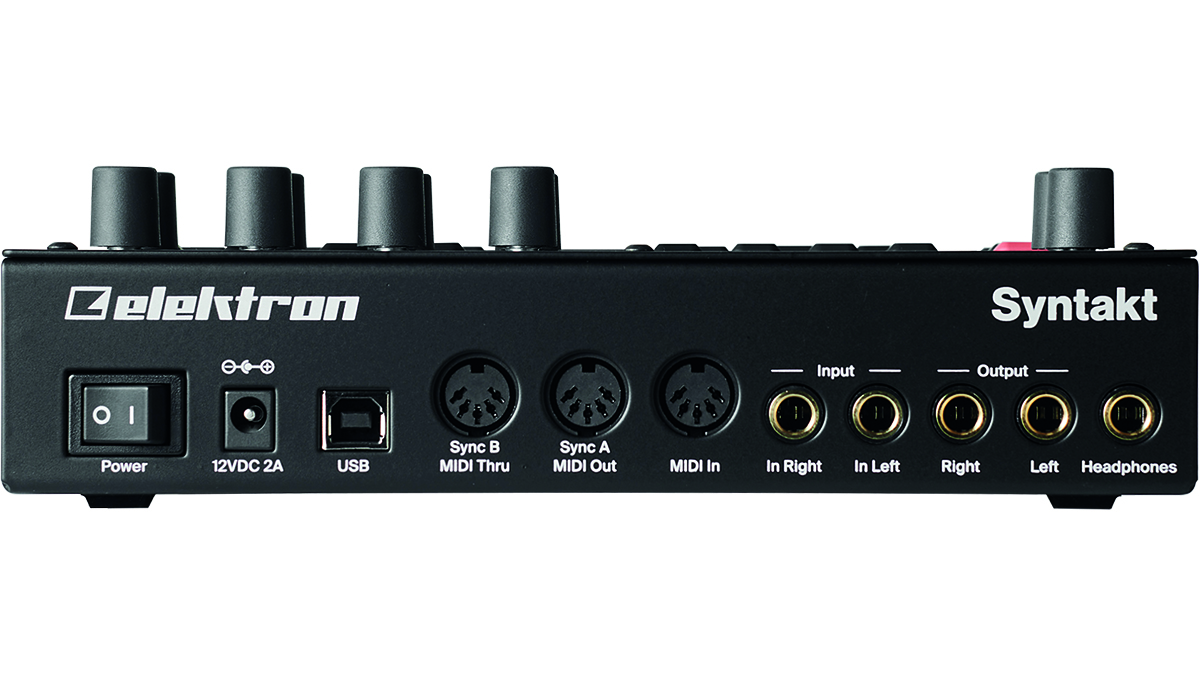
Elektron Syntakt: Performance and verdict
In terms of its sound engine, Syntakt has a lot in common with Elektron’s Analog Rytm, not only in its use of analogue percussion synths, but also in the way it uses distinct ‘machines’ to generate different types of sound.
However, whereas Rytm balances out its analogue elements with sampled hits, Syntakt combines analogue synthesis with FM-derived digital generators.
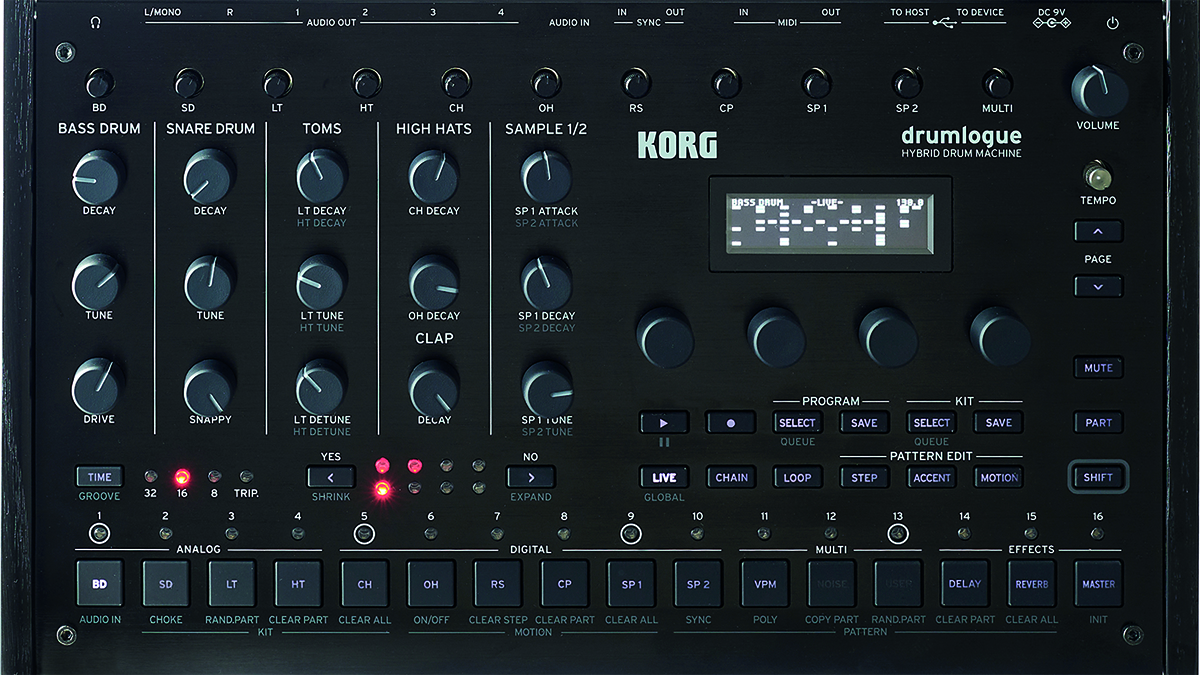
• Korg Drumlogue
Also blending analogue and digital, Korg’s new drum machine is slightly less slick, but it’s also cheaper.
• Elektron Digitakt
Syntakt’s sample focussed sibling has a similar workflow and form factor, but with a different sonic remit. They pair nicely too.
• Roland TR-8S
Roland’s drum machine pairs faux-analogue sounds with samples and basic FM percussion, creating a very broad palette.
There are 12 tracks in total here, of which four are analogue and eight digital. In all cases, each track can be assigned one of several ‘machines’, which are effectively base presets specialising in a certain sound type or synthesis style.
The analogue tracks are divided into three drum tracks and one cymbal track. The drum tracks can each make use of a selection of 19 machines, which include a variety of kick drums, snares, rim shots, tonal synths, and noise and impulse generators. The cymbal track offers 13 machines, covering assorted hat and cymbal types, plus noise and impulse again.
It’s these analogue engines that have benefited from Elektron’s free 1.30 OS update. This has added three new modes to the analogue drum tracks and a new analogue cymbal generator, all of which are inherited from the Analog Rytm.
Of these, SD Acoustic and BD Acoustic are the most straightforward. As the names suggest, these are aimed at creating more realistic and natural drum sounds from the analogue engines. While they hardly offer the realism of a multi-sampled acoustic kit, the engines are handy for creating the more subtle and flat tones you’d find with a non-synthesised drum.
As with all of Syntakt’s machines, these can be pushed into realms beyond their intended remit by altering parameters or playing the sounds at pitches beyond their usual range – the acoustic snare, for example, can become a surprisingly handy melodic synth, particularly with a touch of portamento or some modulated pitch bends applied.
The newest hi-hat machine, HH Lab, is a lot of fun. This makes use of six individually tunable oscillators in order to create layered cymbal sounds. This comes to life with the application of modulation to the tuning of these oscillators.
Of the added machines, SY Chip is the most notable. This is inspired by the SID chips used in the Commodore 64 home computer, which also provided the basis for Elektron’s debut instrument, the SidStation, back in 1999. This uses a fast arpeggiator to create the sonic illusion that a monophonic synth is playing a chord. While this was a digital approach in those C64 computers, here it’s applied to the analogue sound engines. This results in some wonderfully crunchy synth tones of the style associated with chiptune music. It adds a whole new tonality to Syntakt and is a real asset to its overall design.
The digital tracks, meanwhile, are all identical, with 11 machines covering kicks, snares, cymbals/hats, claps and percussion, plus a selection of five tonal instruments. These digital machines are FM-based, derived from those found in Model:Cycles, albeit adjusted to offer more control over sound shaping and match Syntakt’s signal flow.
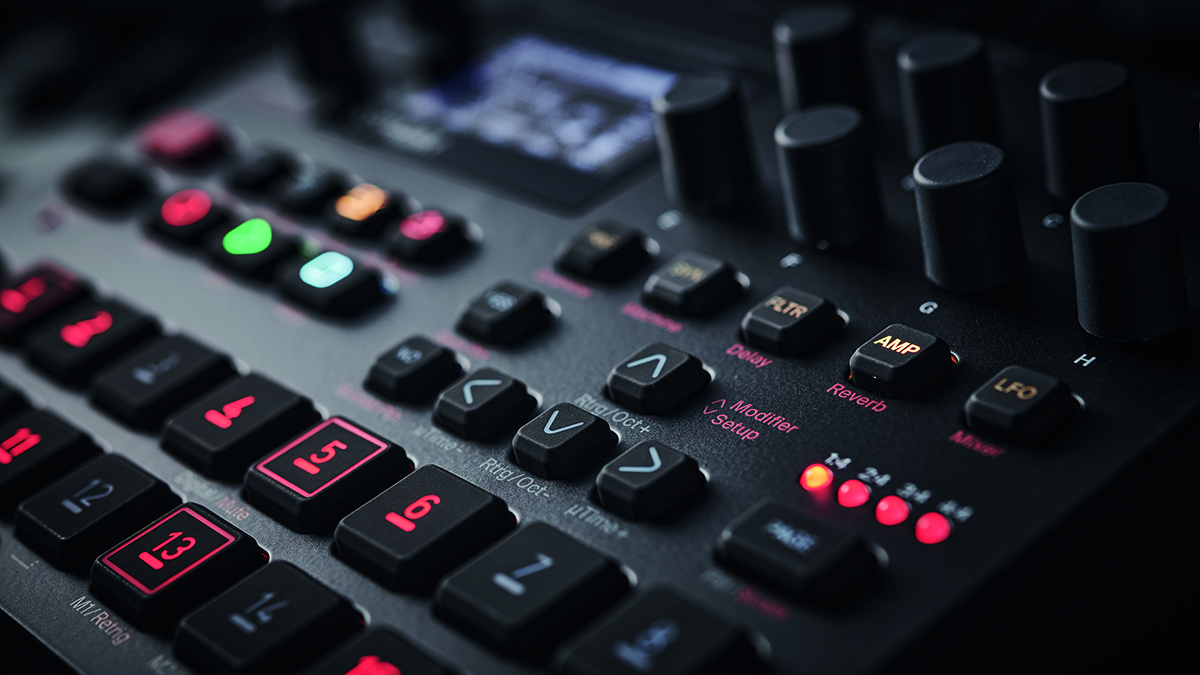
While it might be tempting to think of these digital engines as a lesser counterpart to the analogue headliners, many of Syntakt’s best sounds can be found here. We’ve long been particularly keen on digital FM synthesis as an approach to drum synthesis. While the analogue machines are great for characterful synth lines, the stability and range that comes with digital synthesis means it can produce incredibly precise and hard-hitting percussive tones. Having both of these characteristics present in one box is essentially Syntakt’s greatest asset.
Sound shaping
Overdrive is great; Syntakt is capable of some brilliantly meaty, saturated drum hits
While each machine is preset-like in its basic setup, each has up to eight adjustable parameters that can be controlled from Syntakt’s Synth view. The precise setup of these changes for each machine, but they generally offer decent depth in order to adjust the tuning, shape and timbral qualities of each sound.
Beyond this synth section, each machine follows a broadly similar signal path, first through an overdrive module, then resonant multimode filter and into an amp.
Each machine also has its own ADSR envelope to shape the filter cutoff, an envelope – switchable between ADSR and AHS – for the amp, along with two flexible LFOs that can be routed to pretty much any parameter in the signal flow. Modulation can also be routed from external MIDI sources such as velocity, aftertouch and pitchbend.
There are a few small but key differences between analogue and digital tracks. For the former, the machines, overdrive, filter and amp are all analogue, but controlled by digital modulators and accompanied by a digital noise generator. The digital tracks are end-to-end digital, and add a second base-width filter in before the resonant filter. Every track can also be switched to become a MIDI machine, where the sequencer outputs to external gear rather than sequencing the internal engines.
Although percussion is Syntakt’s obvious focus, there’s a lot of sonic range available from the full line-up of machines. On the drum side of things, the balance of analogue and FM covers everything from classic x0x-alike tones to modern metallic percs and gritty, noisy hits. The inclusion of multiple types and sources of overdrive is a great touch, and particularly in the case of the analogue machines it means that Syntakt is capable of some brilliantly meaty, saturated drum hits. To point out the obvious, Syntakt’s overall sound leans toward the synthetic – don’t expect the sort of realism you’d get with a sampling drum machine, particularly when it comes to the crisp, metallic cymbals. Within the remit of synthesised percussion though, this is one of the most versatile machines going.
That flexibility reaches into more tonal and melodic realms too. There’s plenty of creative fun to be had by ditching the percussion parts entirely and using only the tonal generators to create purely melodic patterns. Used as such, the analogue generators can double as remarkably meaty two-oscillator monosynths, while the digital generators can create chord stabs, crunchy bit-crushed melodies, tuned percussive hits and ‘swarms’ of six detuned oscillators, which work great for throbbing pads and drones.
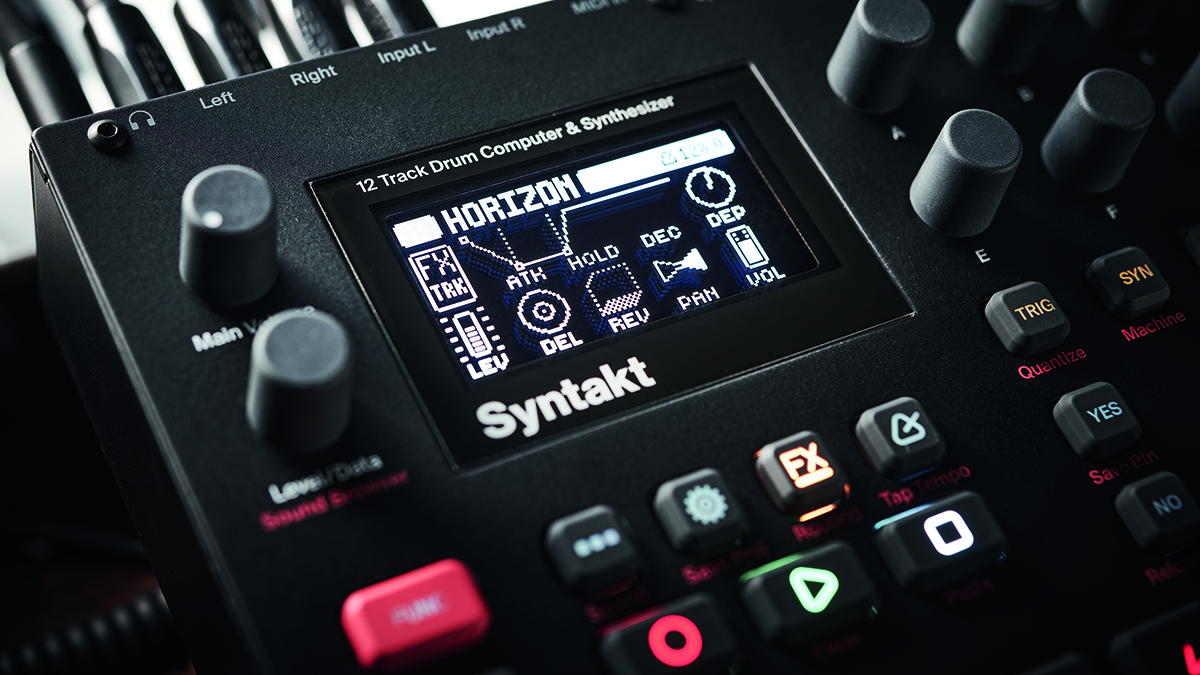
Alongside the sounds themselves, Syntakt packs a solid complement of effects. Each track can be sent to reverb and delay auxiliaries, which will be familiar to users of Digitakt and Digitone. While these aren’t the most versatile effects out there, each has controls for adjusting the timing, plus filters for shaping the output.
Syntakt also features a separate analogue effects channel, which combines an additional drive circuit with a resonant multimode filter, along with its own envelope-controlled amp section. The effects track also has its own filter envelope and two LFOs routable to any of its parameters. Any of the other tracks can be routed here, and it gets its own virtual output when used with Overbridge [see below]. As mentioned, the various sources of drive and distortion are the stars of the show, but it’s a well rounded set of happening tools altogether. A master compressor and EQ would be nice, but you won’t feel hard done by.
The sequencing workflow is characteristically deep and creative. As with Digitone and Digitakt, the 64-step sequencer boasts full per-step parameter automation, probability and conditional triggers, and plenty of flexibility over playback speed, individual track lengths and step micro-timings.
As of the 1.30 update, this sequencing workflow has been expanded with the addition of a Euclidean sequence generator, similar to that present of the recent Digitakt II. This works by using two pulse generators that will spread triggers evenly across a set number of steps. Users can then make use of a Boolean operator to alter how these two lines of pulses interact. It’s a great tool for inspiring interesting polyrhythms, and brings a touch of Eurorack-like sequencing influence that suits the remit of Elektron’s instruments.
One further thing worth mentioning is Syntakt’s Modifiers. These are a pair of modes that let users play any sound combined with up to four preset parameter changes. Essentially these let users trigger multiple alternative versions of each sound. It works particularly nicely for jamming with different chord shapes or bursts of reverb and delay-heavy percussive FX. Along with these, the sequencer also has retrigger and velocity modifiers, the first of these creates a quick way to generate rolls and fills across four different beat divisions, while the latter lets users quickly trigger four different levels of velocity. Syntakt’s effects track has its own sequencer lane too, where users can input triggers for the track’s LFO, amp envelope and/or filter envelope, with the same probability controls as the other tracks.
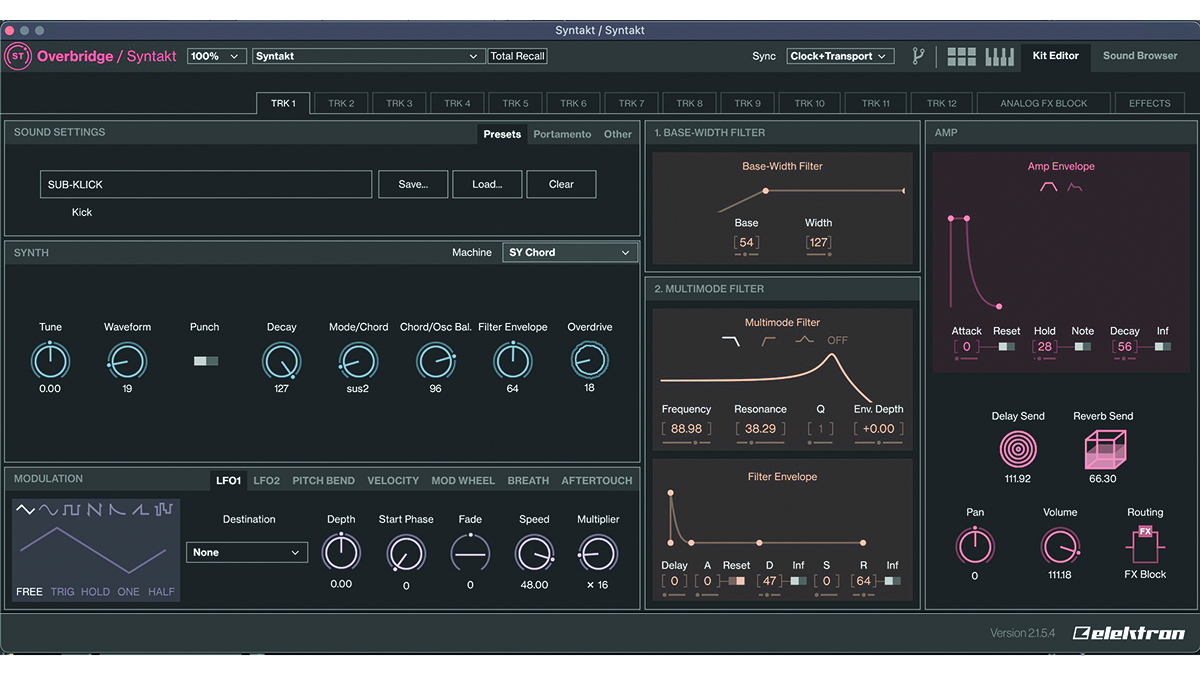
Overbridge
Elektron’s Overbridge lets any piece of Elektron gear function as a plugin in your DAW, with full streaming of audio from/to the hardware via USB, along with total recall of all parameters.
From a studio point of view this really adds to the usability, as it lets users individually output every channel, including the effects block, for individual processing, all without affecting any analogue I/O on your audio interface. It also means that almost all of the synth’s parameters can be automated and modulated like any other VST, depending on how your chosen DAW is set up.
Overbridge’s interface is nicely designed too. If nothing else it offers a clear and understandable layout of what’s going on under the hood of Syntakt.
Verdict
Although Syntakt is an obvious counterpart to Digitakt and Digitone, it’s also a bit like a greatest hits for Elektron, with many of the features that made its two siblings so popular but sounds and effects that build on elements of the Analog Rytm, Model:Cycles and even Analog Heat. The fresh selection of sounds added in v1.30, adding ideas from the most recent Rytm update and Digitakt II, only enhances this sense of Syntakt being a bit of an Elektron ‘best of’.
We’d argue its biggest drawback is the lack of analogue outputs, with just two main outs and a headphone output on the rear panel. This leaves no option for individually processing the 12 tracks when used in a purely hardware setup, although Overbridge offers a simple way around this for studio use and laptop performances.
When it comes to all-out versatility, Syntakt is arguably outdone by Digitakt II, now that Elektron’s sampler has had its audio track count, memory and stereo capabilities vastly improved. Even bearing this in mind though, Syntakt remains our personal favourite of the Elektron range. Between synth lines, hard-hitting percussion and flexible, hands-on sequencing, it really taps into precisely what we look for in a hardware groovebox. It might not be cheap – and some will understandably baulk at the near $/£1000 price – but you’ll be hard pressed to find a more capable percussion synth than this.
MusicRadar verdict: Building on the successes of multiple other Elektron instruments, Syntakt is a top quality groovebox with a lot of power under the hood.
Elektron Syntakt: The web says
"Durable, flexible and excellent-sounding at home in the studio or onstage, Elektron has done it again with Syntakt."
MusicTech
Elektron Syntakt: Hands-on demos
Elektron
loopop
Andrew Huang
Captain Pikant

Elektron Syntakt: Specifications
- KEY FEATURES: 12-track hybrid groovebox with four analogue tracks, eight digital tracks, plus an analogue effect track and reverb/delay sends.
- CONTACT: Elektron
I'm the Managing Editor of Music Technology at MusicRadar and former Editor-in-Chief of Future Music, Computer Music and Electronic Musician. I've been messing around with music tech in various forms for over two decades. I've also spent the last 10 years forgetting how to play guitar. Find me in the chillout room at raves complaining that it's past my bedtime.
“Excels at unique modulated timbres, atonal drones and microtonal sequences that reinvent themselves each time you dare to touch the synth”: Soma Laboratories Lyra-4 review
“I used everything I knew about music”: How Green Day exceeded expectations with their most ambitious song
YouTube just added AI tools that makes musicians, library music and video editors redundant
